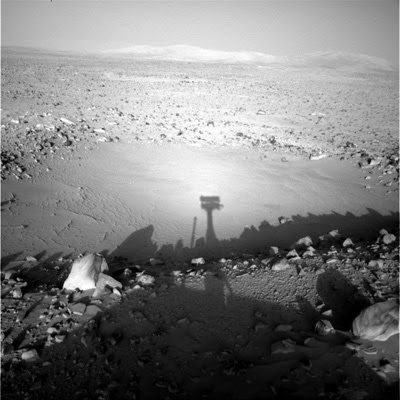 Why Is The Sky Blue
Why Is The Sky Blue Why Is The Sky Blue
Why Is The Sky Blue"Because it reflects the sea ...." -- ScienceMadeStupid
Sunlight is white. The atmosphere breaks that up (better wording?) into a seemingly blue sky and a yellow sun. At night, the moon reflects sunlight. Why, then, does the moon appear to be white, and not yellow? -- FalkBruegmann
Ah, now this one's easy: The Sun gives off yellow light. This is polarized during the day to give you a blue sky. The moon looks white because there isn't enough light reflected from it to let the eye pick up the colour. (The human eye contains two types of photo-detectors: cones, which can detect colour, but require a lot of light; and rods, which can't detect colour, but work much better in low light conditions). -- RogerLipscombe
I don't think I buy this one. A full moon gives off a lot of light - enough to read by, and you read with your cones. And easily more than several colorful neon signs that spring to mind. I think a simpler explanation is that the moon looks shades of grey because the moon is shades of grey. Check out the old moonlanding pictures - only thing colorful there is old glory. -- PeterMerel
I'll buy that: the moon shines by reflected light, whereas the sun is self-luminant. Have you ever seen a moon-bow? If there's a full moon, and just a little high-altitude cloud (or very thin lower clouds) you can clearly see refracted (not scattered) colours around the moon.
The sun is really very nearly white. Against a blue background it appears more yellow. In any case, there is quite enough light from throughout the spectrum to reflect the "true" color of things. Also, it isn't polarization that makes the sky blue. It's reflection (and/or refraction?) and the prism effect. -- KielHodges
OK. You got me. I'm wrong. That'll serve me right for using half-remembered Physics lessons as evidence. After a spot of research with AltaVista, I found the following information:
It's all down to scattering. As the light from the Sun (almost white) enters the upper atmosphere, it is scattered by the air molecules. Now, it turns out that blue light scatters more easily. This makes the sky blue, while leaving the other colours (red and green) to make the Sun appear yellow.
This also explains why the Sun is red at sunset - the distance the light has to travel through the atmosphere is increased, so more of the blue/green end of the spectrum is scattered - leaving the red part of the spectrum.
It's simple really. -- RogerLipscombe
There's a bit more to it though. I've seen a five minute exposure by moonlight. The sky was blue.
In one of the the more autobiographical areas of TheCuckoosEgg, CliffordStoll mentions that "WhyIsTheSkyBlue?" was a favorite question of doctoral defense interrogators in the Astronomy department where he got his degree. -- MichaelFeathers
A quick search at Yahoo reveals http://world.std.com/~mmcirvin/bluesky.html.
But the answer is something called Rayleigh scattering and it goes something like this:
Scattering is the emission of radiation by molecules due to oscillation of electrons caused by passing EM waves (like those from the Sun). (The molecule becomes polarized at the frequency of the incident EMR.)
Rayleigh scattering is proportional to wavelength^-4. Blue light has a shorter wavelength than red and so is not scattered as much as the red thus reaching us on the ground.
Ah, this is one of my favorite questions. When asked why I got an MS in Physics, I often use it as an example. By my 3rd semester of graduate school, WhyIsTheSkyBlue was finally answered to my satisfaction. And that answer is: Biology! The sky is really violet, but our eyes are more sensitive to the slightly longer blue wavelengths.
In fact the sky varies in colour. When the sun is overhead the horizon is deep blue. When the sun is on the horizon the zenith is blue and the horizon opposite the sun is violet.
A minor correction Channing, the shorter blue wavelengths (and violet!) are scattered more (nearly 90 degrees) and the longer oranges and reds pass nearly straight through the atmosphere.
Thanks Greg - I was winging it a bit on that last bit. :-) -- ChanningWalton
-- GregVaughn
Another question along these lines is, "WhyIsSpaceBlack?"? This turns out to have a non-trivial answer.
Actually, I've read several times that the moon is actually dark-gray, roughly comparable to worn asphalt. It only appears "white" because it's the brightest thing in the sky at night. It is difficult to tell white from gray without something to compare to. The exception is near full moon when moon-dust acts kind of like a road reflector and reflects back a lot of light. If I remember correctly, this is because moon-dust has a lot of glass beads and/or silicone crystals that reflect more light back at the angle it came from than to the side. You can see what almost looks like a bright halo around shadows in Apollo photos when the 'nauts photograph their own shadows due to this "return angle" affect.
Mars seems to also have the "return angle" characteristic, as seen in this rover photo:

 EditText of this page
(last edited October 12, 2010)
or FindPage with title or text search
EditText of this page
(last edited October 12, 2010)
or FindPage with title or text search